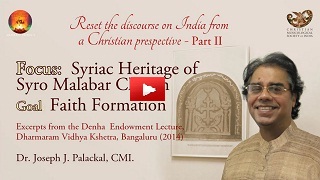
AP 330 to 321
FOCUS & GOAL of ARAMAIC PROJECT: JOSEPH J. PALACKAL, CMI.
| Call Number | AP 327B |
| Part Number | Part I - Syro Malabar Church |
| Title | Focus and Goal of Aramaic Project : Joseph J. Palackal, CMI |
| Duration | 1m:29s |
| Place of Recording | Denha Lecture at DVK Bangaluru |
| Date of Recording | 2014 |
| Youtube URL | https://www.youtube.com/watch?v=YTINhyMFOjM |
| Video Segment (s) |
|
Notes
DISCOURSE ON INDIA Part II FOCUS & GOAL of Aramaic Project by Dr. Joseph J Palackal CMI at DVK Bangaluru.
RESET the discourse on India from a Christian perspective Part II:
Focus and Goal of Aramaic Project by Dr. Joseph J Palackal.
Excerpts from the Denha Endowment Lecture, DVK Bangaluru, 2014
The outstanding Oxford scholar Sebastian Brock has underscored the importance of the Syriac heritage as a “third lung,” along with the “two lungs” (the Latin West and the Greek East) of the Church made famous by Pope John Paul II (Brock 2005 & 2008). Our focus here is on the Syriac heritage of the Syro Malabar Church. We shall use the term “Syriac heritage” to mean a broad spectrum of items that include the different aspects of the Syriac language, liturgy, theology, music, poetry by West Asian poets, as well as such Indian poets as Alexander the Indian (Fr. Chandy Kadavil, 1588-1677) and Saint Kuriakose Elias Chavara (1805-1871), prosody, performance practices and rhythmic cadences that are unique to the Syriac tradition; more importantly, the Syriac heritage also implies, in the words of Fr. Charles Pyngott, C. M. I., the “Aramaic way of thinking.” Obviously, we shall discuss here only a few of these items briefly. Our goal is to increase awareness and appreciation for the unique cultural heritage of Kerala, to discuss ways and means to preserve it for posterity, and to add it to the broader conversation on the wonder that is India.
The Aramaic Project
With the above mentioned goals in mind, the Christian Musicological Society of India (www.The CMSIndia.org) embarked on the Aramaic Project, in 2012. In the ensuing years, through the concerted efforts of several individuals, the Society has collected a vast body of information through recordings of performances and interviews of resource persons in the Syro Malabar communities in Kerala and abroad. Remarkably, the resource persons include not only priests and bishops, but also ordinary people, who are often sidetracked by official church historians. The recordings are posted with liner notes on the web site of the Project. The web site will also serve future scholars for a comparative study of the history of the Aramaic language and music in the Middle East and India. Besides, the archive is a current witness to the status of this Semitic language in contemporary India. The Project is also a proactive step toward passing the tradition to the present generation. Even if that attempt fails, the archive will remain as the final chapter in the centuries-long history of a language lying on its deathbed. At this juncture, it is not difficult to envision a future Kerala, where the sound of the East Syriac language is a nonentity. Appallingly, most of the members of clergy as well as the hierarchy of the Syro Malabar Church seem to be already reconciled with that possibility. Using sharp-edged swords of sheer negligence, they are shredding the over-two-thousand-years long umbilical cord that connects the Sunday Eucharistic tables in their churches to the Passover meal in the Upper Room in Jerusalem that St. Thomas the Apostle partook of.
The Aramaic Project is only a small part of the larger project of creating a digital library of Christian music in India. Christianity in India has interacted with the cultural milieu of the country and has assumed an identity of its own, unlike anywhere else in the world. This unique identity is evident in the various styles of music and lyrics in multiple languages in different parts of India. The ultimate goal of the Christian Musicological Society of India is to collect as many samples as possible and make them available to scholars for further research. These materials are a goldmine for researchers on Indian culture, because they are a testimony to the cultural synthesis that has happened in India over the centuries.
Joseph J. Palackal, CMI
DVK, Bangaluru 2014.
Keywords : #nazrani #marggam #Nazranimarggam #syromalabarchurch #christianityinindia #aramaicproject #Syriacheritage #Syriactradition #syromalabarchurch #aramaicproject #nazrani

